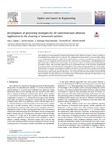Development of processing strategies for 3D controlled laser ablation: Application to the cleaning of stonework surfaces

No accesible hasta 9999-99-99
Use este enlace para citar
http://hdl.handle.net/2183/35526Colecciones
- Investigación (EPEF) [590]
Metadatos
Mostrar el registro completo del ítemTítulo
Development of processing strategies for 3D controlled laser ablation: Application to the cleaning of stonework surfacesFecha
2020-03Cita bibliográfica
López AJ, Lamas J, Pozo-Antonio JS, Rivas T, Ramil A. Development of processing strategies for 3D controlled laser ablation: Application to the cleaning of stonework surfaces. Optics and Lasers in Engineering 2020;126:105897. https://doi.org/10.1016/j.optlaseng.2019.105897.
Resumen
[Abstract] Laser cleaning is an environmentally friendly method based on laser ablation processes to remove impurities or contaminants from a surface layer of a material. The configuration of a laser station in the case of flat surfaces is not complicated because laser irradiates from a fixed position. In contrast, controlled laser processing of 3D surfaces is not yet completely solved because the laser beam must be scanned along a three dimensional (3D) path. In this paper, a 3D laser processing strategy was developed to achieve an accurate and successful cleaning of freeform surfaces. Laser processing trajectories can be programmed directly on the 3D surface model instead of the 2D projection, which ensures both constant fluence and constant scanning speed all over the 3D surface during the laser processing. The strategy was applied to the removal of spray paint from a granite carved skirting board in order to validate the 3D cleaning system. The results, evaluated by means of hyperspectral imaging, stereomicroscopy and scanning electron microscopy, were compared with those of the surfaces treated with the same parameters but deactivating the 3D processing system. These analyses confirmed the improvement of the cleaning process when the 3D processing system is applied.
Palabras clave
3D laser processing
Laser ablation
Paint removal
Carved stone
Granite
Laser ablation
Paint removal
Carved stone
Granite
Versión del editor
ISSN
1873-0302





